by Rajan P. Parrikar
First published on SAWF on December 11, 2000
The various prakars of Kanada are surveyed in the next two parts. In essence, these are a play around the Kanada kernel discussed in Part 1.
Raga Suha Kanada
The dhaivat is varjit in most Suha releases. An alpa rishab in arohatmak prayogas and a strong shuddha madhyam characterize the raga. Its essense is contained in the following tonal sentence:
n’ S (M)g (M)g M, (M)g M (P)n–>P, (P)n M P S”… (P)n–>P (M)g M, R S
The Kanada markers are discernable. Ramrang‘s composition quickly bares the lakshanas. Notice the recurring (M)g M, M n P as well as the P S” interval: aba ghara jane de.
Bhimsen Joshi belts out a traditional Suha cheez attributed to “Sadarang.” Note the (M)R M P usage of rishab, occasionally found in some treatments: tu hai Mohamadshah.
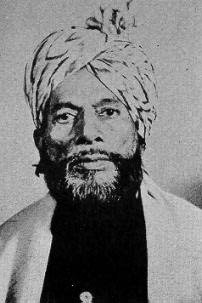
Mushtaq Hussain Khan
Mushtaq Hussain Khan (1880-1964) of Rampur-Sahaswan sings the old composition, piya banjara. Later, we shall find it cast in Sughrai. Mushtaq Hussain‘s Suha adopts the R M R P cluster on the mukhda and this combined with movements in the uttaranga lead to an avirbhava of Sarang, which is then quickly dissipated by the dominant Suha machinery.
The Agra snapshot offered by Latafat Hussain Khan deviates from the canonical Suha outlined earlier first in the S R (M)g usage of rishab and then via a Sarang-like avarohatmak n P M R S. The alert reader will hear a shuddha nishad en route to the tar saptak shadaj in the antara. This arohi-only shuddha nishad-laden phrase – M P n P N S” – occurs in several Kanada prakars. By now the nexus between the Sarang and Kanada ragangas should be obvious: a soupçon of Sarang is residual in most Kanada melodies. Its influence in Suha must be minimized so as not to tilt it towards Sughrai.
Mogubai‘s version is the odd one out, peppered with Sarang-inspired gestures that imperil Suha by inclining it towards Sughrai. However, the Atrauli-Jaipur Sughrai claims other features which we shall come to in a moment. In this short recording, a strong Suhaic madhyam is suggested although never quite realized.
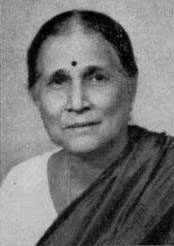
Mogubai Kurdikar
K.G. Ginde adheres to the canonical Suha outlined by Ramrang. The madhyam is brightened by a direct approach from S, as in S M. The traditional bandish is set in Tilwada: aaja re badhawa.
The final Suha item, courtesy Jitendra Abhisheki.
By now the reader should know what to look for. When we are done with Nayaki and Sughrai it is hoped that we will attain to some clarity in the Kanada space. Remember: the raga name in itself is not important; ability to flesh out its internal structure and pattern is. And even that is ultimately not as important as the capacity to soak in and enjoy the melody.
Raga Sughrai Kanada
This old raga comes in at least two distinct versions, one without and the other with (shuddha) dhaivat. The former type is more common. The key idea in Sughrai is the intertwining of the Kanada and Sarang angas.
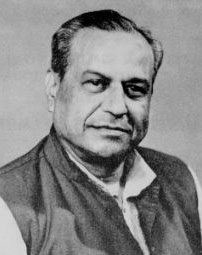
K.G. Ginde
The definitive phrase in most treatments is considered to be: nnPMRS R (M)g. Unlike Suha, Sughrai looks to pancham for its nyasa sthana.
In the first clip, Jha-sahab sings a composition of Anwar Hussain Khan “Rasrang.” Freewheeling linear sorties of form N’SRMPNS”R”SNPMRS R g are observed.
Since there is overlap in the lakshanas of Suha and Sughrai, oftentimes the two are bundled together and sung as Suha-Sughrai. In this lovely composition of Krishnadas, the saint-composer from the Vaishnavite Vallabh sampradaya, Jha-sahab holds forth on matters of Suha & Sughrai: barasata rasa boondariya.
Omkarnath Thakur quickly scythes to the raga core in this traditional bandish: ma’i kanthuwa.
The Agra statement retains the essence of the earlier versions. We have already scraped an acquaintance with this composition, albeit in Suha. The heavyweight Vilayat Hussain Khan: piya banjara.
Now watch the same composition morph again in the Atrauli-Jaipur hands. Take stock of the mukhda. The Sarang-anga surfaces but there’s a noticeable change in flavour. Mallikarjun Mansur.
Kesarbai Kerkar sings another traditional Sughrai bandish.
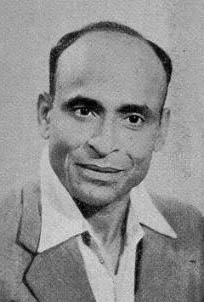
Mallikarjun Mansur
The second dhaivat-laden variety of Sughrai is advanced by K.G. Ginde. Here we have dhaivat appearing via D n P, à la Shahana but the dominant Sarang strain in Sughrai reins it in. This is Bhatkhande’s composition: piya bina.
Raga Nayaki Kanada
Nayaki plies gestures similar to Suha with one phrase all its own: R n’ S R P (M)g. Its poorvanga is redolent of Darbari – the gandhar treatment, to be precise. There is also a quick flourish of the form gMPMRS R, S.
A sample chalan:
S, R n’ S R P (nM)P (M)g, M, gMPMRSR, S, S R (R)g M, M n–>P
Sharad Zambekar is a veteran of Marathi stage music. From the play SHIKKA KATYAR: tuzya vina bhavana.
Another natyageeta – chandra hava ghana – from MEERA MADHURA. Composer: Jitendra Abhisheki, Singer: Ramdas Kamat.
Ramrang‘s composition, where the raga is dehisced in the first line itself: barani na ja’i chhabi.
K.G. Ginde‘s assay in a traditional composition set in Tilwada: banara mora pyara.
The Darbari influence as well as the shaken (but not stirred) phrase gMPMRSR S are visible in this selection of the Rampur-Sahaswan vocalist Ghulam Mustafa Khan. The vilambit composition E maga varana is attributed to Mehboob Khan “Daraspiya” and the druta to Anwar Hussain Khan “Rasrang”.
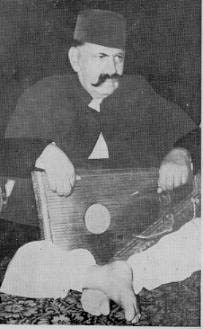
Bade Ghulam Ali Khan
The next three Nayakis are from the Atrauli-Jaipur camp. They share the bandish – mero piya – with the Agra musicians. This Nayaki is a departure from the canonical, i.e. the R P sangati is deemphasized. But the other lakshanas are retained, eg. S R (R)g (R)g and gMPMRSR and (M)g M (P)n P.
Mogubai Kurdikar. Notice the komal dhaivat at 0:43 into the clip. Nayaki admits of this d very occasionally in a S” (n)d (n)d n P cluster. Mogubai also clearly intones the R-P sangati.
Raga Shahana Kanada
With Shahana we step into the less visited reaches of the Kanada ragaspace. Here the shuddha dhaivat holds court and is the nyasa sthana. The gist of Shahana can be summarized thusly:
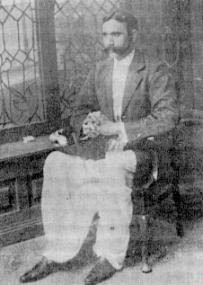
Alladiya Khan
– n D n P, D M P S”
– (S”)D (D)n P, M P (M)g M D,
– n D n D (P)n P, n P (M)g M (S)R
The raga steers clear of both Bageshree and Bahar and has a swaroopa altogether its own. It should be clear by now that in the Kanadas a linear run of the form S R g M P is seldom executed. The prayogas are vakra by design, and mediated by kans & meends.
Jha-sahab: chanchala chapala si.
Patiala’s Fateh Ali sketches a textbook Shahana.
Shaila Datar with a traditional composition attributed to Sadarang: more aaye hai Kunwar Kanha’i.
Basavraj Rajguru iterates the same composition but with some textual and melodic interpolation.
Shivkumar Shukla‘s composition sundara angana baithee is cited in Jha-sahab’s Volume II of Abhinava Geetanjali. Amir Khan.
The Shahana dealt by the Agra musicians has a decidedly unique flavour. The shuddha gandhar is introduced via a tonal phrase of the type R n’ S R G, M reminiscent of Gunji Kanada, but the remaining features conclusively help reinstate Shahana.
Latafat Hussain Khan‘s gagari mori bharana.
Raga Raisa Kanada
Allied to Shahana, this raga is the preferred choice of the Atrauli-Jaipur musicians. No consensus prevails as to its swaroopa, but there is broad agreement about a special tonal construct around shuddha dhaivat.
Jha-sahab delineates the chalan and keeps it distinct from Shahana. His special D-cluster assumes the form – n DPD PMP.
The Agra interpretation is not too far off from Ramrang’s. It recruits shuddha dhaivat in MP, P D, D n and a quick MPDnS”. Vilayat Hussain Khan with the well-known ri tum samajh.
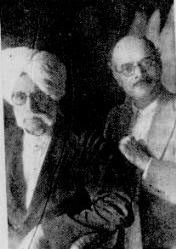
Alladiya Khan and
Govindrao Tembe
The Atrauli-Jaipur masters deal the same composition with their own spin, of course. Here we find Mallikarjun Mansur in bed with Raisa (not to be confused with Gorbachov’s late wife).
A rare recording of Kesarbai Kerkar.
Raga Devsakh
Four traditional “Sakhs” are recognized by tradition: Devsakh, Ramsakh, Bhavsakh and Lacchasakh. Of these the last named (Lacchasakh) is a Bilawal prakar, the rest are Kanadas. And Bhavsakh comes in two angas, Kanada and Bilawal. All the Sakhs have become scarce, and only Devsakh is occasionally heard in performance today. Jha-sahab has documented traditional dhrupads in all the Sakhs as received from his guru. These are today the carriers of the original genetic blueprint of these ancient ragas.
The sangati g-P (G-P in Lacchasakh) is the key lakshana of the Sakh clan. The dhaivat is dropped in Devsakh and a bit of Sarang-anga alongside Kanada is observed, as Jha-sahab explains before sketching his bandish: panaghata roke mero gail.
A composition of S.N. Ratanjankar presented by his pupil K.G. Ginde: nanadiya mori jage.
Although the Sarang-anga is heard in this Atrauli-Jaipur Devsakh by Mallikarjun Mansur there is no g-P sangati. This composition is shared by the Agra musicians: hans karana duva dalana.
The same composition by Khadim Hussain Khan of Agra.
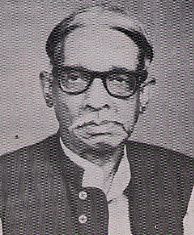
Khadim Hussain Khan
Raga Bhavsakh
The version circulated by Ramrang contains both dhaivats, and treads thus:
S M, M P (M)g (M)g P M, (P)n P D n R” S”, (n)d n P
Another type of shuddha dhaivat-only variety comes to us from the Agra musicians. The D is taken in an avarohatmak prayoga – M P D, D P – as is evident from this clip of Khurjawale Aslam Hussain Khan.
A composition in dheema Ektala by the Agra veteran, Khadim Hussain Khan.
Raga Ramsakh
This raga today lies moribund. It employs both gandhars, both nishads and shuddha dhaivat. There are strains of both Bilawal and Shahana.
The Kanada story continues in Part 3.
